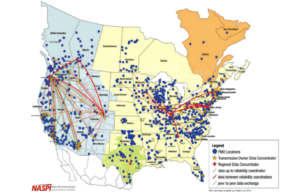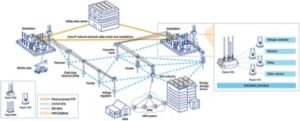 By BERT TAUBE, Ph.D.
By BERT TAUBE, Ph.D.
“Smart Grid” is a term coined in the early 2000s to refer to the necessary electric grid modernization in the U.S. and worldwide. The current grid is dominated by a system that is mostly electromechanical in nature, with centralized generating capacity, and one way in its communication with little or no feedback to centralized decision makers. The transition to a digital network with two-way communication, a network topology with distributed generation, grid storage, pervasive control systems, sensors, and self-monitoring presents extremely attractive opportunities to increase efficiency, reliability, and security.[1] Smart Grid is also called the intelligent grid or modern grid.[2]
In the U.S. the modernization of the electric utility transmission and distribution system to upgrade to a “smarter” grid is addressed in Title XIII of the Energy Independence & Security Act of 2007, which represents the only major piece of federal smart grid regulation. It is composed of a number of sections to define the statement of policy on the modernization of the U.S. electricity grid, the smart grid system report to be delivered to Congress starting one year after the enactment and every two years thereafter, the smart grid advisory committee and the smart grid task force to guide R&D and standards development for smart grid, smart grid technology R&D and demonstration to develop digital IT for the smart grid, the smart grid interoperability framework to develop protocols and standards for information management that allow smart grid devices and systems to interoperate, the federal matching fund for smart grid investments, state considerations for smart grid, the study of effects of private wire laws, and the DOE study of security attributes of smart grid systems. In addition to Title XIII, there are several states that have created state legislation to facilitate the development of smart grids. Examples of state legislation include SB 17 in California, SB 1592 in Illinois, and SB 205 in Maryland.
Since inception of the smart grid regulation, there have been a variety of U.S. and international smart grid initiatives. Smart grid programs in the U.S. include utilities such as Arizona Public Service, Austin Energy, Con Edison, Duke Energy, Electric Power Board, HydroOne, Oklahoma Gas & Electric, Oncor as well as the three California IOUs – PG&E, SCE and SDG&E. Those addressed a multitude of areas such as microgrids, storage and renewable integration, virtual power plants, fault self-isolation and healing, distribution automation, T&D upgrades to enhance reliability, system wide smart meter deployments as part of advanced metering infrastructure (AMI) solutions, communication infrastructure, substation upgrade, electricity pricing models, time-of-use (TOU) pricing programs, demand response programs, energy efficiency, transformer health monitoring, interoperability and distributed intelligence or VVAr optimization. Recent smart grid initiatives include SCE’s new Grid Management System initiative to redefine the utility information system architecture as one that reflects the necessary innovations embraced by smart grids. Another recent smart grid initiative is reflected by the outage data initiative started in 2014, when the White House Office of Science and Technology Policy challenged electric utilities and software providers to find an approach to share outage data to foster power restoration and data availability during grid events. There are also initiatives to drive value-based analytical utility services. Last but not least, there are substantial efforts to introduce more cloud-based services into the utility business models to leverage substantial technical and economic benefits from the deployment of cloud infrastructures.
But how can all those initiatives be put into an overall perspective that describes the benefits, but also the challenges inherent in the transformation towards a smarter grid? The following points discuss a variety of critical aspects to answer this question:
Power Generation and Delivery – Process Transformation
The first step to enable grid intelligence is to build new innovative technologies and resulting process improvements into the existing power generation, delivery and consumption process in order to enhance the current process architecture.
Power Generation
Besides the already established conventional forms of power generation (e.g. nuclear, coal, hydro), there have been a number of alternative energy resources established recently to diversify the energy mix towards a more environmentally friendly global economy that reduces global carbon emissions and mitigates climate change. Typical representatives of new alternative energy resources are PV, wind, biofuel and biogas, hydrothermal and more. Besides the climate change aspect driven by the energy mix, there is also the challenge with the peak load caused by the fact that, for a couple of rather small time windows each year (a few days each), extreme temperatures are to be dealt with. As a result, there is an extreme amount of additional energy needed to run heating or cooling units in order to deal with those. Since the additional amount cannot be provided unexpectedly by the conventional forms of power generation (e.g. nuclear or coal), power producers need to keep certain reserves at all times that can easily be activated and provided, but get lost at the same time if not used. While more precise weather forecast models help to keep the reserves down to the necessary minimum, the approach to reserve rather substantial amounts of energy for an unforeseen emergency is not a good concept. One alternative could be available alternative energy resources, if those can be stored properly and then made available quickly whenever needed. This, however, assumes mature energy storage solutions, which are not yet available at scale. The distributed character of alternative energy resources represents another challenge, since the electric circuitry of the power delivery system constantly changes with massive amounts of active power sources everywhere in the electric grid. As a result, complex network models need to deployed and constantly adapted in order to reflect the correct network behavior at all times.
Power Transmission
The power transmission network is also called the bulk grid, which works at higher voltage levels (e.g. 500kV or 345kV) to transmit power over larger distances using HVAC or HVDC power transmission systems depending on the specific distances. The power transmission network brings the energy closer to where it is transformed down to lower voltage levels and then provided to the end-customers via the power distribution network. The usual enhancements to power transmission networks are new transmission lines to increase transmission capacity where needed or Flexible AC Transmission Systems (FACTS), which allow to increase power quality, stability, power factor correction or transmission capacity of the existing system. FACTS also allows to increase situational awareness and control in decentralized areas where they are installed using information from additional measurement units, which is then also used to feed power electronics that allow to control the grid at that particular point. The challenge with this approach, however, is that it does only cover specific areas of the grid, rather than all of it.

Besides enhancing the power transmission network with new transmission lines and power quality systems (e.g. SVC, TSC, FSC, STATCOM, UPFC), there is a continued effort to install alternative energy resources at the transmission level where feasible. One example includes the Ivanpah Solar Electric Generating System is a concentrated solar thermal plant in the California Mojave Desert, 64 km (40 miles) southwest of Las Vegas, with a gross capacity of 392 megawatts (MW).

Power Distribution
The power distribution network covers the final distance for the power to “travel” to the consumers. Since the distances are smaller, the voltage level of power distribution networks is low (e.g. 10kV) compared to the level in transmission. While power transmission networks are quite developed in terms of the components that compose them, power distribution networks are much less modernized. Many of the components needed to improve controllability and power quality are still missing. Many times, breakers or disconnect switches need to be operated manually, not to mention the lack of sensors and monitoring equipment. The communication infrastructure in power distribution shows substantial deficiencies as well. The rollout of “smart” meters or automated meters to eliminate manual meter reading represented a first step to design two-way communication between the utility and the consumers. However, there are still substantial efforts needed to establish reliable and robust data communication between the end nodes where the consumers are located and the utility head-end. Current AMI solutions allow 15min to 1h meter readings to be communicated back to the AMI head-end every 6 hours using a data batch transfer approach. Certainly, this represents substantial progress compared to what it used to be, but it does not allow for real-time or near real-time situational awareness and dynamic control solutions. Also, the circuit diagrams of the power distribution networks are constantly changing due to continued integration of alternative energy resources at the customer premises. It poses a big challenge to keep up with the change from the utilities’ perspective. More on the topic of integrating distributed energy resources, such as micro grids, roof-top solar and other on-site power supplies, and storage into more centralized power distribution networks is discussed in the Electric Power Research Institute report on “The Integrated Grid: Realizing the Full Value of Central and Distributed Energy Resources.”
Power Consumption
Not too long ago, utilities would not conduct more than one meter read per month to understand the customer. In fact, utilities would not even make the effort to understand load behavior at all. This certainly changed with the smart grid legislation introduced in the early 2000s. Nonetheless, there is still way to go to really understand and forecast from the bottom up how appliances aggregate to the overall customer load, how load can be managed at the customer level, and how this all should be correctly translated into utility rates using economically viable approaches, such as dynamic pricing in real time. It will also require that the communication between the customers and the utilities are made customer friendly and less time consuming for both sides. Demand response programs introduced to help utilities reduce peak loads have not been as effective as originally hoped. Automation is missing to reduce the amount of attention needed from consumers and utilities to run this type of load reduction process. Customer analytics are another component where better solutions are needed to get actionable insight at the customer level shared with the utility to take the necessary action.
Power Generation and Delivery – Process Automation
The following summary perspectives focus on the design, engineering and deployment aspects for more integrated monitoring and control (automation) solutions that will enable us to better automate the power generation, delivery and consumption process by building in the necessary intelligence which will in turn provide the foundation for grid learning and adaptation so we can make the grid smarter. Provided the integration of more and more intelligent sensor, actuators and controllers this will include distributed as well as centralized grid intelligence and learning to enable the “Grid of Things.”
Interestingly enough, the term “smart” is misleading, as it has been used interchangeably with the term “intelligent.” While most people use both notions assuming the same meaning, there is a difference as “smart” refers to an earned status from learning about a specific subject matter while “intelligent” represents a naturally-provided ability that measures the ability to become “smart” through learning.
Based on much better understanding and modeling of the overall power generation and delivery process, integrated system models can be derived that look at the overall power delivery process from the holistic standpoint.[3] Once proper models are derived, a proper measurement solution can be designed to “listen” into the power delivery process where it makes most sense. Current approaches are not integrated. The placement of sensors and measurement systems is rather random. Process modeling through network studies is not the usual approach as it requires additional highly qualified resources to analyze and model the complete power generation, delivery and consumption process. At the same time, a good network model is the necessary prerequisite to build process observers, predictors and controllers which make up the feedback look necessary establish the desired grid intelligence. In fact, other industries such as telecommunications or industrial manufacturing had to go through the same learning curve, until they finally realized that proper modeling and reflection of the process behavior is key to come up with integrated automation solutions. These allow for multi-input, multi-output and multi-loop feedback control, leveraging a proper measurement and sensing system to monitor and respond to the process needs in real-time to enhance power quality, avoid power flow congestion, and island problematic areas in the power delivery network. Advanced analytics can then also help the process automation level to provide intelligent reference values for dynamic feed-forward and feedback control.
A properly defined measurement system will also be crucial to redefine the utility information system world, such that the respective areas addressed by each system are adequately determined. In today’s utility enterprise system world, systems are mostly separate and not well integrated at all. The lack of automated information flow is compensated for by spreadsheet downloads to manually close the gap. As a result, situational awareness lacks, and information based real-time control/decision making is the exception to the rule. Model-based control with self-learning and self-tuning capabilities does not exist. This, however, will be needed to entertain an intelligent grid automation that will then allow the grid to become “smart.” There is a long way to go in order to achieve an intelligent grid that can learn and become smart. Process modeling and automation will be the main key to accomplish what has really been mandated from us. While the theory of model-based process identification, monitoring and control has long been established and optimal, digital, adaptive, self-tuning control is a reality in other mission-critical industries for several decades the utility industry has still to come up with a wide adoption of these powerful options to enable an intelligent grid that is capable of learning.
The following Figure 3 illustrates the complexity of developing and deploying a structured wide-area measurement network. More specifically, it shows the various data flows from transmission owners to regional hubs between reliability coordinators and transmission operators driven by the synchrophasor network composed of thousands of PMUs (Phasor Measurement Units), which have now been placed all over the U.S. and Canada to share operational data across wide interconnections. While the ongoing deployment of the PMU network in North America represents a crucial step in building a more intelligent power delivery infrastructure, it also demonstrates the still missing lack of integration of the data that becomes available from them, as well as the algorithms to convert the deluge of data into actionable information to create the wide-area situational awareness that is needed to prevent brown and blackouts from happening.

Source: DOE Quadrennial Technology Review September 2015
One key component to enable an intelligent, wide-area, networked power delivery infrastructure via feedback loops with intelligent sensors, controllers and actuators is the communication between all the “intelligent” nodes which will compose the future grid network of networks. The following diagram illustrates a good example for utility network communication architectures.

Source: Wireless Field Area Networks, Key Foundation for Smart Grid Applications, by Bert Williams
Making the right choice of communication technology is crucial for building effective feedback loops. It will determine the learning power from the degree of intelligence installed through the communication performance. It will decide whether the grid will be capable of real-time situational awareness to allow for informed decision making in-time or not.
While communication via wires is still a highly regarded option, the trend clearly shows more and more adoption of wireless communication networks for a variety of reasons such as cost, operational convenience or simply because of the catalyzing effect to increase the deployment of intelligent sensors, controllers and actuators towards and at the grid edge. At end nodes (e.g. premises) devices such as smart meters and embedded sensors will need to be compatible with standard communication protocols including the necessary cyber security and data privacy.
Another critical aspect for the development and deployment of utility communication infrastructures is the question whether to use regulated or unregulated frequency spectra. This will have important implications in terms of availability of standard communication protocols, network accessibility by private and public stakeholders, compatibility and bandwidth, and last but not least security implications. It will also be driven by the availability of wireless communication technology as its development is driven by the before mentioned criteria.
Also, it is critical to look at the question if the communication technology adopted allows for event driven rather than batch driven data communication. For example, looking at AMI communication networks deployed so far batch driven data communication between smart meters and utility head-ends are the mostly used approaches. This bears a tremendous disadvantage because of the delay in the data and information availability by at least several hours. As a result, real-time situational awareness is not an option, and true real-time process automation cannot be done because of “lack of intelligence.”
A smart grid panel hosted by Leaders in Energy on March 22nd will discuss the subject matter of data communication networks as a critical piece of the feedback control and monitoring loop architecture to enable more intelligence for smarter networked power infrastructures.
Concluding Thoughts on Process Transformation and Automation
We need to get back to the integrated and systemic approach, rather than claiming that data analytics will take care of business (typical computer science approach). We need to bring the systemic Operational Technology (OT) approach — which concerns the physical features of the system involving the electrons that are transferred and consumed — together with the data-centric information Technology (IT) approach. IT/OT convergence will be one of the most critical challenges to successfully master if we want to succeed. We will need to integrate the various systems and components into an overall process description if we want to get away from the piecemeal approach found in today’s utility infrastructures. We will need a new generation of systems engineers who combine the knowledge provided in computer sciences[4] with the expertise taught in electrical systems engineering and automation to be able to properly adopt best-in-class technologies in order to create an intelligent grid that can learn to become smart and justifies the term Smart Grid.
—
Bert Taube has spent more than 20 years with technology and consulting companies such as Siemens, General Electric, Versant, Supertex, and DNV GL creating, developing, leading, and delivering high-tech projects to large-scale, mission-critical infrastructure such as power delivery, electric transportation, and industrial manufacturing. These projects leveraged a variety of capabilities such as Big Data analytics, real-time automation, meter and outage data analytics, asset management, energy efficiency, demand response programs, utility load research, and forecasting as well as utility financial solutions and distributed energy resources. Bert earned a Masters and Ph.D. in Technical Cybernetics and Automation from the University of Rostock in Germany and an executive MBA from the Kellogg School of Management at Northwestern University. Bert is a member of Leaders in Energy and was recently recognized as its 2000th member.
[1] Dr. William Kao, Sensor Devices and Sensor Network Applications for the Smart Grid/Smart Cities, Sensor Con 2012, https://www.iot-summit.org/English/Archives/201203/Presentations/Bill_Kao_SensorsCon2012.pdf
[2] The Electric Power Research Institute has referred to the use of enabling technologies to modernize the grid as the “IntelliGrid.” In 2015, the IntelliGrid program became the Information and Communication Technology Program and will continue to focus on enabling technologies for modernizing the grid, fusing Information and Communication Technology (ICT) into every aspect of electricity service. Utilities around the world are embracing the concepts of this modernization as demonstrated by increased attention to deploying additional sensors, enabling the mobile workforce, focusing on data analytics, and managing Information Technology/Operations Technology (IT/OT) convergence. https://smartgrid.epri.com/IntelliGrid.aspx
[3] This more holistic system model is also discussed in the paper by Roger N. Anderson, IEEE member et al, titled “Adaptive Stochastic Control for the Smart Grid.” 0199-SIP-2010-PIEEE, available at: https://castlelab.princeton.edu/Papers/AndersonBoulangerPowellScott-ASC%20IEEE%20Smart%20Grid%20Jan2011_final.pdf
[4] The need for a new generation of systems engineer is also noted in article by Roger Anderson et al in his article Adaptive Stochastic Control for the Smart Grid


Leave a Reply